

Ohio University
1968 Bobcats
(Authentic Reproduction)
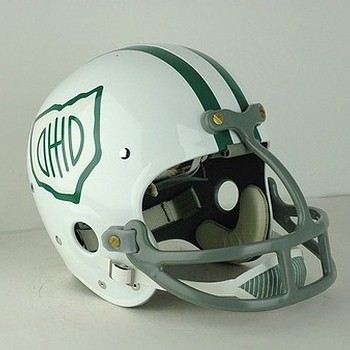 |
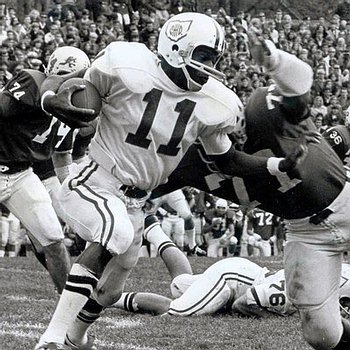 |
When the casual college
football fan hears the words “Ohio football” they immediately think “The
Ohio State University.” Even throughout the 1950’s and ‘60’s, one’s first
thought regarding football would have been “Ohio State” but the discerning
fan, appreciative of football taught by superb, expert coaches and executed
at the highest levels of precision, would just as easily have thought of the
Ohio University Bobcats. Those who wore the green and white of OU know that
they did not have to take second seat to Ohio State. Founded in 1804, Ohio
University is the oldest university in the State of Ohio, one of the longest
established in the United States, and has the distinction of receiving the
nation’s first federal land grant. A consistent contender for the Buckeye
Intercollegiate Athletic Association Championships until becoming a charter
member of the Mid American Conference in 1946, the decade that spanned 1959
through 1968 saw the Bobcats win four MAC championships.
The triumvirate of Ohio,
Miami, and Bowling Green State Universities were the conference kingpins and
the Bobcats in this noted ten year period usually found themselves battling
Bowling Green for the coveted title. The undefeated 10 – 0 1960 MAC
Championship Ohio squad was also recognized as the Small College National
Champions and head coach Bill Hess was named The Ohio College Football Coach
Of The Year. With terrific college football and a bucolic setting emphasized
by its river valley and majestic surrounding hills, the many white picket
fenced homes and churches made Athens, Ohio a central focus for true
connoisseurs of the sport.
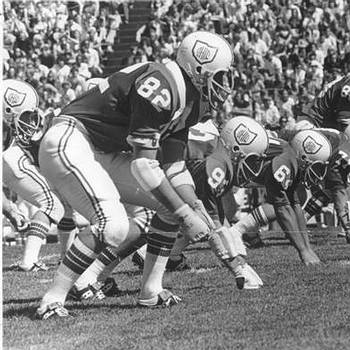 |
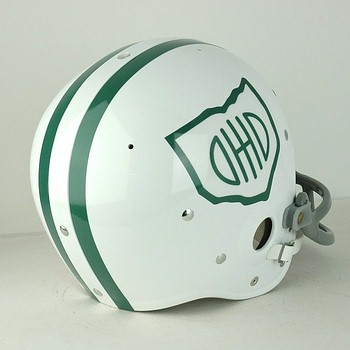 |
In contrast to the defensive play that was the hallmark of the great early ‘60’s Bobcats teams, Ohio University’s 1968 team displayed an explosive offense, highlighted by a 60 – 48 fireworks victory over Cincinnati, the nation’s total passing offense leader. In a Mid America Conference whose members placed five different teams among the nation’s rushing or passing defense Top Ten, OU did it with their offense. Those who were carefully observing knew that something big was brewing for ’68. The ’65 season’s 0 – 10 record was difficult but by 1967 the team had rebounded to a 5 – 5 mark that included a victory over Big Eight Conference runner-up Kansas, and a tie for the MAC title with Toledo. Coming together for 1968, the undefeated regular season saw an average scoring output of 37.6 points per game, tremendous numbers for this “run first” era of college football and a MAC Record that stood until 1997. The 10 – 0 Bobcats had numerous stars on both sides of the football, none as bright as quarterback Cleve Bryant and his favorite receiver Todd Snyder. The results were dizzying with the twentieth ranked Bobcats posting Bryant as the MAC Player Of The Year. Bryant finished ninth nationally in total offense and Snyder caught seventy-nine passes for 1406 yards and seven touchdowns. Rushing leader Dave LeVeck, part of the Watkins, Ohio High School pipeline that had directed three-time All MAC performer Skip Hoovler to the Bobcats for the bowl game rewarded 1962 team, finished ’68 with 850 yards and All Conference honors with ample run support from fullback Bob Houmard. The 1968 squad was also rewarded with a bowl trip, and faced the 8 – 3 Richmond University Spiders in the Tangerine Bowl. In a stirring, offensively dominated contest Richmond displayed their version of Ohio’s potent Bryant-to-Snyder combination with Spider quarterback Buster O’Brien throwing to the Tangerine Bowl’s Most Valuable Player Walker Gillette. Named as a First Team All American in 1969, Gillette’s twenty receptions for 242 yards kept Richmond a step ahead of the Bobcats and Bryant’s four touchdown passes, resulting in a very exciting 49 – 42 finish. Despite the bowl game loss, the Bobcats and their striking power were lauded and finally given their much deserved national recognition. Snyder became a third round draft choice for the Atlanta Falcons in 1970 and lasted three seasons as a wide receiver. Bryant fell short with the Denver Broncos but had a lengthy career as a college coach and both very deservedly were inducted to the Ohio University Athletics Hall Of Fame.
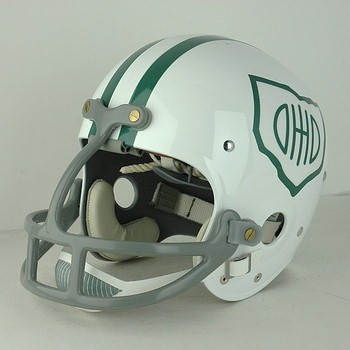 |
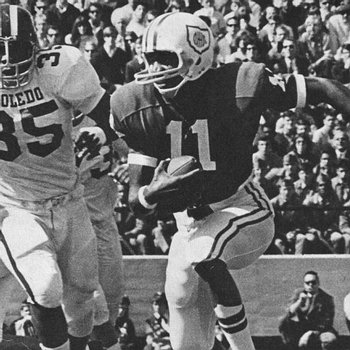 |
On the field, the Ohio team displayed a unique helmet logo on both sides of the white shell which caught the fancy of many college uniform devotees. The one - inch Kelly green flanking stripes were perfectly augmented by the Kelly green outline of the State of Ohio, featuring the word “OHIO” within the borders. This design was in keeping with Coach Hess’ penchant for displaying the school name prominently. The ’68 team, like some earlier squads, bucking the American Football League trend of placing player names on the back of the jersey or the more common practice of having nothing more than the player’s identifying numeral on the back, proudly had “OHIO” stitched across the top of each jersey, above the rear numerals. The effect, in conjunction with the unique helmet decal, was striking and different, and gave the great 1968 Ohio University football team one more distinctive characteristic.